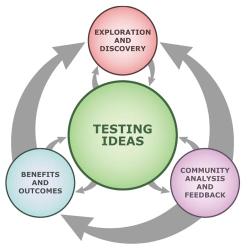Source Institutions
Source Institutions
Add to list Go to activity
Activity link broken? See if it's at the internet archive

Learners conduct an experiment to determine the rate at which two materials, sand and water, heat up and cool down. Then, based on their observations, they make hypotheses about why materials heat up and cool down at different rates. Learners conduct experiments with new materials to test their hypotheses and share their results with the group. Use the Science Flowchart to help learners examine their scientific process.
- 5 to 10 minutes
- 45 to 60 minutes
- $5 - $10 per group of students
- Ages 11 - 14
- Activity, Experiment/Lab Activity, Lesson/Lesson Plan
- English
Quick Guide
Materials List (per group of students)
- 500 ml beakers, two per group of four students (beakers can be any size, but all beakers should be the same size)
- Thermometers, two per group of four students
- Lights with incandescent bulbs, per group of four students
- Stopwatches, one per group of four students
- Sand
- Water
- A variety of other materials. Suggestions: Sand and water mixed together, salt water, tea (room temperature), dirt (or potting soil), mud (try several types of mud of different thicknesses, with different amounts of water), gravel, rocks, leaves, sticks, cut grass
- Data sheets
- Graph paper
Subjects
-
Mathematics
-
Data Analysis and Probability
- Data Analysis
- Data Collection
- Data Representation
-
Measurement
- Units of Measurement
-
Data Analysis and Probability
-
Physical Sciences
-
Heat and Thermodynamics
- Heat and Temperature
-
States of Matter
- Solids
- Liquids
-
Heat and Thermodynamics
-
The Nature of Science
-
The Scientific Process
- Asking Questions
- Conducting Investigations
- Gathering Data
- Formulating Explanations
- Communicating Results
-
The Scientific Process
Audience
To use this activity, learners need to:
- see
- read
- touch
Learning styles supported:
- Involves hands-on or lab activities
Other
Components that are part of this resource:
This resource is part of:
Access Rights:
- Free access
By:
- Skene, Jennifer
Rights:
- All rights reserved, The University of California Museum of Paleontology, Berkeley, and The Regents of the University of California, 2010
